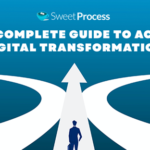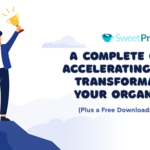Driving Digital Transformation With a Data-Forward Approach
Last Updated on April 10, 2022 by Owen McGab Enaohwo
Are you running your business based on data or assumptions? A business that isn’t data-driven is vulnerable to risks.
As the head of operations analytics at Calpine, an integrated energy company, Rajeev Aluru streamlines the organization’s business operations from a data-driven perspective to prevent risks and drive digital transformation.
Rajeev Aluru is the guest in this episode of the Process Breakdown Podcast. He speaks with host Chad Franzen about his experience in championing data-driven business improvements.
Listen to the interview
Subscribe for more business success stories
Key Resource List
SweetProcess — Sign up for a 14-day free trial. No credit card is required.
Show Notes
[0:26] Intro
- Chad Franzen mentions some of the past guests who have been on the show, including David Allen of Getting Things Done and Michael Gerber of the E-Myth.
- Chad Franzen introduces SweetProcess, a workflow tool that helps businesses to streamline their operations even in life-or-death situations.
- SweetProcess offers a 14-day free trial without a credit card.
[1:23] Chad Franzen introduces the guest, Rajeev Aluru.
[1:44] Rajeev gives an overview of what Calpine does.
- Calpine is an integrated energy company that powers the nation.
- The organization services two and a half million customers with about 25,000 megawatts of assets in the power plant.
[2:46] How does analytics apply to Rajeev’s role?
- Calpine uses data to drive its power operations.
- As head of operations analytics, Rajeev focuses on using the generated data to improve the asset and business.
[4:10] Rajeev talks about the impact of data on the operations at Calpine.
- The organization monitors and diagnoses the plant on a minute-by-minute basis. That way, they notice an anomaly and resolve it immediately.
- Sometimes they observe the data a little longer to come up with the best solutions.
[5:12] How does the team at Calpine implement immediate action when the need arises?
- The organization has thresholds for managing its assets. When the assets go beyond the thresholds, it’s an indication that something is amiss.
- When an action has an immediate impact on the company’s operations, the team swings into action immediately to mitigate damages.
[7:03] Rajeev explains how the organization leverages machine learning and artificial intelligence to improve its business processes.
- The team at Calpine uses machine learning to learn past data with programming as well as without programming to gain insights into different aspects of the data.
- They leverage machine learning and artificial intelligence to increase production without jeopardizing safety and reliability.
[19:18] How relevant are digital transformation and data-driven results in business?
- COVID-19 caused a paradigm shift in the way we do business.
- Before COVD-19, businesses like Amazon, Uber, and Airbnb created a digital culture of doing business.
- Businesses that want to be relevant in the next five to ten years have to think from a digital front.
[11:52] Rajeev talks about how he implements digital transformation at Calpine.
- Rajeev and his team use the data and information generated by their assets digitally to improve their operations.
- They streamline their operations with digital assets to save costs on human capital.
[13:35] How can people find out more about Calpine?
- Visit the Calpine website to get more information about its services.
[13:59] Rajeev mentions his favorite software.
- Some of Rajeev’s favorite software include Tableau, Databricks, Azure Machine Learning, Alteryx, and DataIQ because they democratize artificial intelligence (AI).
[15:22] Outro
About Rajeev Aluru

Rajeev Aluru is the head of operations analytics at Calpine, an integrated energy company. With a vested interest in technology and analytics, he’s passionate about driving business growth through efficient operations.
Rajeev is a trusted C-suite advisor whose expertise includes executing data-driven transformation and building successful cross-functional teams.
In various manufacturing industries such as energy, automotive, and aerospace, Rajeev has delivered revenue targets in the range of $50M and operational cost savings in the range of $20M.
Transcript of this interview
Speaker 1: Welcome to the Process Breakdown Podcast, where we talk about streamlining and scaling operations of your company, getting rid of bottlenecks, and giving your employees all the information they need to be successful at their jobs. Now, let’s get started with the show.
Chad Franzen: Chad Franzen here, co-host of the Process Breakdown Podcast, where we talk about streamlining and scaling operations of your company, getting rid of bottlenecks and giving your staff everything they need to be successful at their job. Past guests include David Allen of Getting Things Done, and Michael Gerber of the E-Myth, and many more.
Chad Franzen: This episode is brought to you by SweetProcess. Have you had team members ask you the same questions over and over again, and this is the 10th time you’ve spent explaining it? There’s a better way and a solution. SweetProcess is a software that makes it drop dead easy to train and onboard new staff and save time with existing staff. Not only do universities, banks, hospitals, and software companies use them, but first responder government agencies use them in life or death situations to run their operations. Use SweetProcess to document all the repetitive tasks that eat up your process time, so you can focus on growing your team and empowering them to do their best work. Sign up for a 14-day free trial, no credit card required. Go to sweetprocess.com. That’s sweet like candy, S-W-E-E-Tprocess.com.
Chad Franzen: Rajeev Aluru is Head of Operations Analytics at Calpine, where he has led digital transformation efforts in customer solutions and operations, including end to end product development. Rajeev, thank you so much for joining me today. How are you?
Rajeev Aluru: I’m good. How are you, Chad? Thank you very much.
Chad Franzen: Good. Thank you.
Chad Franzen: Hey, so tell me a little bit more about what Calpine does.
Rajeev Aluru: Yeah. Calpine is the energy provider. We call it integrated power company that powers the nation. We have about 25,000 megawatts of assets in the power plant. Most of them are newer generation power plants. And then, the power, if you can think of it as the ability to power about two and half or so million customers. Two and a half million customers is what that really means. So, very big power plant all over the country we operate in unregulated, meaning competitive power markets, such as California [inaudible 00:02:30] Northeast.
Chad Franzen: I noticed that your role is the head of operations analytics. Normally, I just kind of speak with heads of operations. Can you tell me about how analytics applies to your role?
Rajeev Aluru: Yes. So, when you look at the operations, the power operations specifically, we are already using data to drive the operations. And then, the data comes in various forms from various sources. For example, we generate data from the plants every minute from the sensors, and the equipment on the ground gives us data. We also generate quite a bit of data from our home-grown systems that we developed to run the business efficiently and effectively.
Rajeev Aluru: There are a lot of processes that we use for, as I said, not only business excellence, but also compliance and other things. So, all of that data can be used to make things better, and that is the role that I play. How do we take all that data and then improve the value of the asset, thereby increasing the value for the business. That can be a production output increase, minimizing the cost, providing better customer satisfaction or stakeholder satisfaction. So, that’s usually what that means.
Chad Franzen: How often does the data affect your day to day operations? Could you see, "Okay, yesterday this happened, so today we have to do this", or is it more of a kind of a long-term thing?
Rajeev Aluru: No, it depends. For example, we actually do monitoring and diagnostics of the plant on a minute by minute basis, if not periodically. In that, any anomaly or any abnormality that we see will be dealt immediately, like, throughout the day or within a day or so. However, there are certain processes that can wait. For example, if you’re looking at the monitoring of output of a certain plant, that can wait and then, especially, the corrective action can take a little longer. There are times where we have to act immediately. There are times where we can take a little bit of time and do the right thing.
Chad Franzen: Can you give me an example of something where you have had to act immediately and how do you kind of get the ball rolling for immediate action like that?
Rajeev Aluru: Yeah. So, say for example, we are monitoring vibration of an equipment, and then if the vibration… Actually we have a historical threshold that we always operated under that threshold and then, all of a sudden we’re seeing an increased amount of vibration. The impact of that increased vibration can be quick, so that needs to be handled immediately. The guys on the monitoring and diagnostics essentially picks up the phone and talk. Once they do the basic checks they do… Because these were past operators, they actually make sure that it is not a false alarm and all the validations are done, they’ll pick up the phone, and they reach out to the plant operator and then say, "Hey, this is what we are seeing. These are the checks we have done. It looks like something is going on." That is more of a real time and immediate monitoring example.
Rajeev Aluru: And then, obviously, the plant will look at it and then they’ll do whatever is necessary at the point. That can simply mean taking the unit offline if that needs it. And then, informing the services to come in and then do whatever the next steps are.
Rajeev Aluru: Whereas a monthly effort or a weekly effort would simply be the comparison of the plant estimated output to what the real-time output is, and then look at it as an average in terms of is it increasing, decreasing, is it flat. All of that is more of a periodic check.
Chad Franzen: I noticed that part of what you do is to leverage machine learning and artificial intelligence to improve business processes. What does that mean, and how do you kind of do that?
Rajeev Aluru: Yeah. Let’s start with a basic definition of that. Artificial intelligence simply means enabling a machine to simulate human behavior, right? That’s what artificial intelligence is; how can we simulate a human. But to do that, one subset of artificial intelligence is machine learning, where we allow the machine to automatically learn from the past data, with and without programming. Ideally, you want it to be without programming. That’s where they call it unsupervised as you start it and you get into… You start with supervised, and then you get to unsupervised machine learning. That’s the definition out. We actually have a lot of data that we are generating every five minutes, as I already mentioned, which essentially tells me the characteristics of that specific machine, or that set of operating conditions, right? So, that is where we incorporate things like machine learning. And then, we can say, for this set of conditions, here is the output.
Rajeev Aluru: Now, as I get the next day, or the week after, or the next year, if within the same operating conditions, if the output changes, the machine will inform me, not only inform me, but it can also take it to the next level where within the operating envelope, let’s call it, which essentially means the conditions, here are the outputs that actually were given to you, and can I actually help you get there? Can I automatically check you there? So, that is the cognitive automation we call it. But those are some of the things that come in when we say leveraging machine learning and artificial intelligence. Primarily to increase the production without jeopardizing the safety and the reliability. That is the key here.
Chad Franzen: A hot topic lately is digital transformation and data driven business results. Can you kind of define those digital transformation, data driven business results, and why is that so relevant?
Rajeev Aluru: Digital transformation, the word is widely used. It essentially means the process of using digital technologies to create new or modify existing businesses in terms of their processes, their culture, customer experience, so that the business is meeting the new market requirements. So, the businesses have changed, how do they actually change it to meet the new demands? That is where we can use the digital technologies to help the business get there.
Rajeev Aluru: Now, with that said, the key is the changing marketplace. COVID, to name one, a big force that essentially changed the way we work, live, and interact, as we all know. So, those sort of parameters have really shifted the paradigm, I would say.
Rajeev Aluru: But even before that, if you step back and look at it, the names such as the Uber, the Airbnbs, the Amazon, they really changed the culture. Yes, they can be seen as the technology product, but they actually changed the behaviors for us where it’s acceptable to share an asset. It’s acceptable to ride in somebody’s car, for example. It’s acceptable to find pretty much anything online. And then, Uber, where you can have full visibility of who is coming in, when they’re coming in, so on, so forth where time is of essence.
Rajeev Aluru: There is a mindset shift as well from the customer. And to cater to these new customers, the changed mindsets, it’s essential to think like those folks that were running these businesses, the digitally native, if you want to call them.
Chad Franzen: Sure.
Rajeev Aluru: Or digital [inaudible 00:11:17]. That is why it is important if the business wants to be relevant in the next five to 10 years… I know it might come across as a point or a new blunt fact, but if the business wants to be sustainable, relevant in the next five to 10 years, you’ve got to be thinking on from the digital front and lead with that in mind. That is why this is important.
Chad Franzen: So, as operations leader, what’s kind of your process for applying what you just talked about to Calpine.
Rajeev Aluru: As I mentioned before, we use the data and the information generated by assets, systems that we have in place, and we constantly use that to improve the processes, the outcome, the way how we do things. And one of the ways that I want to think of here is valuing the human intelligence. So, historically, you take an analyst, and then the analyst can make the reports, and then they come in and [inaudible 00:12:30] up and down. But most of those tasks, whichever are redundant and repetitive, if the business is okay with it, can you streamline it in such a way that you don’t need a human capital that need to be spent on?
Rajeev Aluru: So, why is leveraging human capital wise is what I would say would be the mission statement, or would be the target where Calpine and others are trying to achieve in this marketplace; smarter, faster, better, and then all of that enabled by data, technology. And then, the domain expertise, not to mention. Okay, you got to have domain expertise, but the business have to be open towards contributing that, and then the whole transformation, the cultural transformation will happen.
Chad Franzen: I have one more question for you, but first just tell me how people can find out more information about Calpine.
Rajeev Aluru: It’s www.calpine.com. You should be able to find out what Calpine does, their energy footprint, and what we are doing for the sustainability and carbon reduction as well.
Chad Franzen: Great. Last question. Tell me, if you could, some of your favorite tools or software that you like to use.
Rajeev Aluru: I like to be usually vendor agnostic, but there are… In various aspects, I can name a few, but more importantly, the characteristics is what I would like to point out.
Chad Franzen: Okay.
Rajeev Aluru: So, this is more about having, we call it citizen scientist, or a citizen developer, or a business analyst, if you want to call it. Somebody who knows the business who doesn’t really know technology, can you make that person use the tool? That is the standard that I really like. And when you actually pose that question, some of the names that come up are, for example, Tableau, or this end-to-end machine learning platforms, such as Databricks, Azure Machine Learning, Alteryx, Dataiku, for example.
Rajeev Aluru: All of these are essentially trying to democratize, so-called "democratized AI" and machine learning, which will make the business processes better by understanding your past, but also incorporating more data, more external information so that you are not only being intelligent based on your past information, but you’re also combining that with excellent information, and then get better in your next steps in the future.
Chad Franzen: Hey, Rajeev, it’s been great to talk to you. Thank you much so much for sharing your time and your insights with us today. I appreciate it.
Rajeev Aluru: All right. Thank you very much.
Speaker 1: Thanks for listening to the Process Breakdown Podcast. Before you go, quick question. Do you want a tool that makes it easy to document processes, procedures, and/or policies for your company so that your employees have all the information they need to be successful at their job? If yes, sign up for a free 14-day trial of SweetProcess. No credit card is required to sign up. Go to sweetprocess.com. Sweet like candy, and process like process.com. Go now to sweetprocess.com and sign up for your risk-free 14-day trial.
Owen: Hi, this is Owen, the CEO and co-founder here at SweetProcess. If you’ve enjoyed listening to this podcast interview… Actually, you know what I want you to do? Go ahead and leave us a five-star review on iTunes. That way, we get more people aware of the good stuff that you get here on this podcast. Again, go on to iTunes and leave us a five-star review. We look forward to reading your review. Have a good day.











Leave a Reply